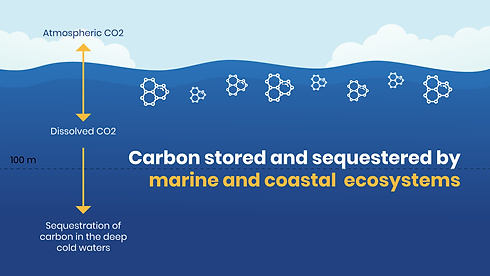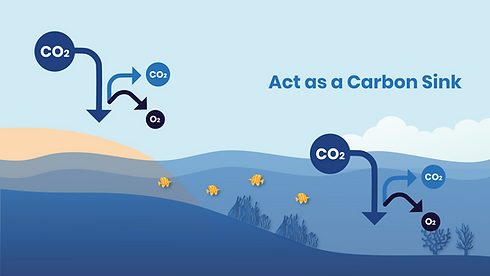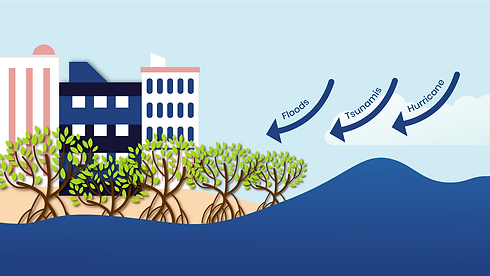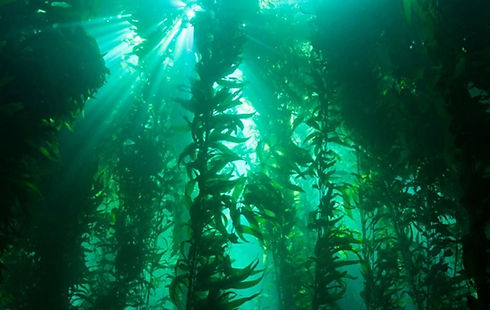

SUB-UNIT 1
What Is Blue Carbon Ecosystem?
Have you ever heard about blue carbon?
Even if you answered no, you actually might know more than you realize.
Blue carbon is simply the term for carbon that is stored and sequestered by marine and coastal ecosystems. The carbon that we, humans, are producing from our activities every day.
(Please check out unit 1 to learn more about how human activities contribute to producing more atmospheric carbon or greenhouse gas emissions.)
As mentioned in unit 2, our oceans provide a natural way of absorbing heat and reducing carbon emissions from the atmosphere. But, how? Well, it’s blue carbon ecosystems that do the job.


Marine and coastal ecosystems such as mangroves, seagrasses, salt marshes, and seaweeds are considered a part of the blue carbon ecosystem.
These ecosystems can “capture and hold” carbon, acting as something called a “carbon sink”.
Most of the carbon taken up by these ecosystems is stored below ground where we can't see it*, but it is still there. The carbon found in coastal soil is often thousands of years old! Blue carbon ecosystems can store up to 10 times more carbon than terrestrial forests. No wonder they play a critical role in addressing the climate crisis.
*Except for seaweed, which stores carbon in its tissues.
Oh! We almost forgot to mention coral reefs. They play an important role in improving air quality and provide an important ecosystem for life underwater. Additionally, they protect coastal areas and provide a crucial source of income for millions of people.


When these ecosystems are damaged, an enormous amount of carbon is emitted back into the atmosphere, where it can then contribute to climate change.

So, protecting and restoring coastal habitats is a good way to slow the climate crisis. Also, any coastal ecosystems or habitat loss can lead to a range of adverse impacts on the long-term health of the marine and coastal environment.
When we protect the carbon in marine and coastal ecosystems, we protect healthy marine and coastal environments that provide many other benefits to people, such as recreational opportunities, storm protection, and nursery habitat for commercial and recreational fisheries.
Now, let’s dive more deeply into each of the ecosystems so that we know what to do to protect, conserve and restore them!

SUB-UNIT 2
Mangroves: The Coasts Guardians
What are Mangroves?





Mangroves are clusters of diverse trees and shrubs that grow in tidal coastal areas. They thrive in saline water and muddy soil and can withstand high temperatures and tides.
Mangroves or mangrove forests serve many vital functions in the coastal regions where they are found including as a protective shield against coastal erosion, a habitat for local flora and fauna, a source of income for local economies which rely on mangroves for fisheries, ecotourism, and as a carbon sink.


Mangroves make up a transitional zone between land and sea, anchoring the shoreline. They also support and maintain coastal ecosystems and protect communities living in coastal areas from damaging storms, hurricane winds, erosion, tsunamis, waves and floods.
The intricate root system of mangroves is home to many of organisms. They are nesting and breeding habitats for fish, shellfish, birds, turtles, crabs, and many more marine animals. Mangrove forests also serve as protection for sensitive habitats like coral reefs and seagrass meadows.


Furthermore, mangroves help increase the clarity and quality of waters by filtering pollutants and trapping sediments. Besides this, they provide invaluable green economy services, supporting the livelihood of coastal communities by providing healthy fisheries and land from which to fish and farm.

Additionally, mangroves serve as a major carbon sequester. They sequester massive amounts of carbon-storing up to 10 times more carbon than terrestrial tropical trees - to combat climate change and also adapt to sea-level rise. Therefore, they are one of the nature-based climate solutions.

Sadly, more than half of the world’s mangrove forests have been destroyed due to flawed developmental activities. In Indonesia, over the last three decades, around 40% of mangrove forests have been destroyed.
This is very concerning given that the country has more mangrove forests than any other country on Earth, making up approximately 23% of the world’s mangrove forest.
The future of mangroves very much depends on us and in fact, our future is co-dependent on the survival of these critical habitats.

SUB-UNIT 3
Seagrass Meadows: The Lungs Of The Sea
Yes! This is about seagrass meadows or you can just call them seagrasses.
Okay, do you know why seagrasses are called the lungs of the sea?
It is because they can generate oxygen every day for all animals living below water. Around 1 meter square of seagrass can produce 10 liters of oxygen.
Hmmm interesting, isn’t it?
There are still many more exciting and surprising things about seagrasses that you need to know. Let’s go through it one by one! and thank us later!!😆


Seagrasses are flowering plants with stems and long green, grass-like leaves which grow in the marine environment. They evolved from terrestrial plants which migrated back into the ocean about 75 to 100 million years ago.
These days they occupy the sea bottom in shallow and sheltered coastal waters anchored in sand or mud bottoms. For this reason, they can slow the flow of water, reducing erosion and buffering coastlines against storms as their roots trap and stabilize the sediment.
Seagrasses that form dense underwater meadows are among the most productive ecosystems in the world.
They provide habitats and food for a diversity of marine life comparable to that of coral reefs, including invertebrates like shrimp and crabs, cod and flatfish, marine mammals and birds. They also provide refuges for endangered species such as seahorses, turtles, and dugongs.
No wonder why they act as nursery habitats for shrimps, scallops and many commercial fish species. Well, that is just fascinating!

Another thing is seagrasses are considered as one of the important carbon sinks worldwide due to their capacity to sequester significant amounts of carbon and store it as organic carbon (Corg) in the sediments for long periods of time.
They can store about 10% of the carbon buried in the oceans each year and capture carbon up to 35 times faster than tropical rainforests. Thus, they can slow the speed of climate change.


Given lots of species that depend on seagrasses, they become important for commercial and recreational fisheries. In fact, in all regions of the world, fishermen will specifically seek out seagrass beds for their abundance of fish, serving as a boon for economic activity in many coastal communities.

Nevertheless, many seagrass meadows are destroyed by human activities such as pollution from land runoff, fishing boats that drag dredges or trawls across the meadows uprooting the grass, and overfishing which unbalances the ecosystem.
So, what do you think you can do about it? Their lives are in our hands!

SUB-UNIT 4
Seaweeds 101
Seaweeds? Are they similar to seagrasses?
The answer is not really!
Unlike seagrasses which we know are plants, seaweeds are non-flowering marine algae without roots, stems, and leaves. This is why they are known as macroalgae. There are thousands of seaweed species that vary vastly in size, shape, and color.
But!!! Like seagrasses, they play a major role in marine ecosystems. They provide habitats for marine lifeforms and protect them from threats. Large seaweeds form dense underwater forests known as kelp forests, which act as underwater nurseries for fish, snails, and sea urchins.

.Seagrass.
.Seaweed.

.This is a kelp forest!.
Seaweeds are mostly found in the intertidal region, in shallow and deep waters of the sea and also in estuaries and backwaters.
They derive nutrition through the photosynthesis of sunlight and nutrients present in seawater, then release oxygen through every part of their bodies. This way, they can naturally increase the local water pH and help balance out the ecosystem as well as shape healthier habitats for other marine organisms.
In addition, seaweeds also act as a good bio-indicator to assess the pollutant level in marine waters. When waste from agriculture, industries, aquaculture and households are let into the ocean, it causes nutrient imbalance leading to algal blooming, showing the sign of marine chemical damage.


Besides, many seaweed species have phytochemicals that are of economic significance. They are high in minerals and fiber, and have gelling properties which lead to their use in cosmetic products and vitamins, and as feed for farmed fish and livestock.

SUB-UNIT 5
Coral Reef: Rainforests Of The Sea!

Have you ever seen the beautiful formations full of color on the ocean’s floor? You may think that they are a type of rock, or a kind of plant, dancing and swinging with the rhythms of the sea. However, they are actually coral reefs!
Surprisingly, coral reefs are actually non-mobile animals whose classification resides between the jellyfish and the sea anemones.
Corals have existed million years away before the dinosaur, colonizing the seafloor by secreting calcium carbonate and forming the hard skeleton. The skeletons are produced on top of the old dead corals, thus, forming multiple layers that eventually form reefs that can be up to thousands of kilometers in length. The largest coral reef in the world is the Great Barrier Reef in Australia with a length of 2,300 km.
Although coral reefs cover less than 1% of the whole seafloor, they are home to almost 25% of all known marine species and provide protection, especially for small fishes. This is why coral reefs are known as rainforests of the sea.


Coral reefs also act as natural coastal buffers and breakwaters that minimize the harsh energy of the sea waves by 97%, including cyclones, hurricanes, and typhoons. Globally, it is estimated that more than 150,000 km of shoreline in 106 countries receive some form of protection from reefs.
Additionally, the potential economic benefit in Indonesia from coastal protection is valued at USD 314 million. Many people living in tropical regions are also dependent on coral reefs' sea ecosystem, especially for fishing and tourism.


BUT, how do coral reefs actually help address climate change?
Well, scientists still debate whether coral reefs absorb carbon or not. However, since corals use the dissolved CO2 in the water to form new reefs, they help to remove excess carbon that might otherwise end up in the air. Therefore, coral reefs help improve air quality and play a role in addressing climate change.
Think you got blue carbon eosystems basics down?
It's time to put your knowledge to the test!
Answer all the questions correctly and get the certificate!
References
Oceanservice | IUCN | Frontiersin | Differencebetween | Wikipedia | Nature | Downtoearth | Gbrmpa | Researchgate | Frontiersin

